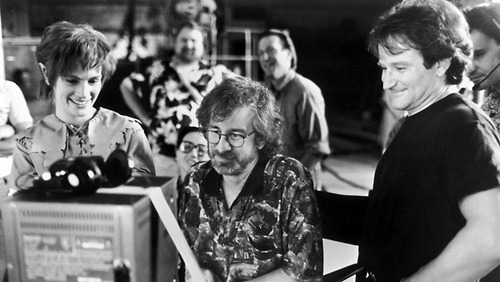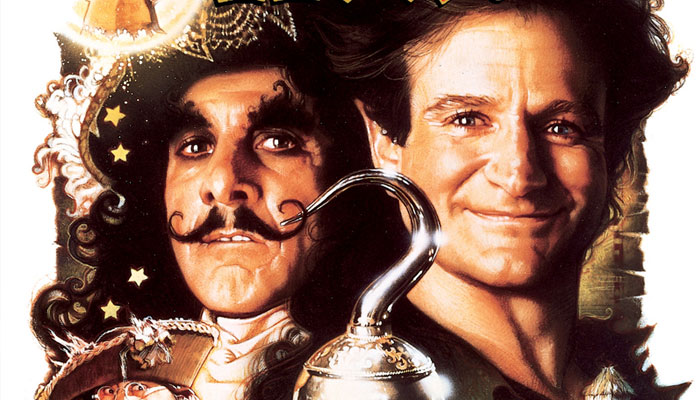Peter Pan is one of those cultural touchstones which tends to have a profound effect in people’s lives. For many, it’s one of the earliest stories told to them, and the details stick because a child’s mind—untainted by the lifetime of experiences that await it– is like a sponge soaking up every little nuance. This was certainly the case for me. The memory of watching Disney’s PETER PAN (1953) on VHS during my fifth birthday party is seared into my brain, not to mention an even earlier memory of seeing the film during my first trip to the movie theatre. I was six when director Steven Spielberg’s HOOK came out in 1991, and it was the first instance where I became cognizant of movies as a big, commercial thing. I remember all the merchandising and tie-ins that was released in the wake of the film, especially the Lost Boys gear. Much like re-watching E.T. THE EXTRA-TERRESTRIAL (1982) the other day, watching HOOK again for the first time in nearly twenty years was a visceral experience for me. I’ve accumulated a lifetime of other memories since then, but watching it again was like returning to that innocent, primal mindset. It’s a testament to Spielberg’s pure, visceral power as a storyteller that he regularly makes such profound marks on the minds of young children. Given the subject matter of HOOK, it’s clear that nobody else could’ve made this story. But over twenty years later, the question still remains: was this a story worth telling?
People my age love HOOK, united by the rose-tinted glasses of childhood and the common refrain of “Rufio! Rufio! Ru-fee-oooooh!”. But in the cynical adult world, HOOK was a very different beast altogether. It was considered an indulgent, sloppy affair with little redeeming value. Spielberg himself had been long perceived as the live-action Walt Disney due to the whimsical sentimentality he brought to his films, so when it was announced he would tackle the ultimate childhood tale that was Peter Pan, nobody was surprised. His involvement with the project began with its gestation in 1983, back when Michael Jackson was attached to play Peter Pan (which makes a perverted kind of sense).

Peter Banning (Robin Williams) is a high-powered attorney and a (increasingly absent) father of two children. One Christmas, he and his family travel to London to visit an old friend of his: Wendy Darling. While he, his wife, and Wendy are away at a benefit gala in Wendy’s honor, Peter’s two children are abducted from their beds. Left alone to his grief and at a loss for what to do, Peter is visited by the feisty fairy Tinkerbell (Julia Roberts) who transports Peter against his will to the magical world of Neverland. Once he arrives, he learns that not only are the stories of Peter Pan true, but that he is Peter Pan—and all grown-up. He’s been away for so long that he’s forgotten how to fly, fight, and crow.
He soon encounters Captain Hook (Dustin Hoffman), who is shocked at the sight of the flabby, middle-aged Pan before him. Peter narrowly escapes with his life and joins up with the Lost Boys, who whip him into shape and help him discover his past and his destiny—just in time to challenge Hook to one last fight to the finish and save his abducted children. In the process of re-awakening the dormant child inside of him, he also learns to become a better father.’
Admittedly, Robin Williams is an eccentric choice for a grown Peter Pan, but I can’t imagine anyone else who could’ve done it better. He’s convincing both as the workaholic attorney with bad parental skills, as well as the childish, wide-eyed Pan. It’s a performance reminiscent of his starring turn in Francis Ford Coppola’s JACK (1996)—except inherently more watchable.
You wouldn’t know it by looking at his normal appearance, but Dustin Hoffman is spot-on casting for Captain James Hook. He absolutely owns the role– so much that friends to this day still use it as a nickname. Hoffman infuses Hook with the requisite sophistication and gentlemanly airs that the animated Disney incarnation established. Quite simply, Hoffman is responsible for any joy felt in watching the film, and he’s the best manifestation of the character that ever has been, or will be.
Julia Roberts brings a 90’s edge to Tinkerbell, as well as pint-sized attitude to the grandiose world of Neverland. Reportedly, she was nicknamed “Tinkerhell” on set due to people finding her difficult to work with (which may have been brought about by an untreated mental disorder, in her defense). Bob Hoskins is yet another example of pitch-perfect casting as Smee, Hook’s bumbling and jovial henchman. He becomes such a perfect representation of the character that he’s since gone on to reprise the role in completely unrelated films. Dante Basco is Rufio, the punk leader of the Lost Boys, and easily the coolest thing about the movie (he still is, damnit). For many in my generation, his death was the first major cinematic death we experienced and it TORE US APART.
Maggie Smith plays the elderly Wendy Darling, bringing grace and sophistication to a frail old woman who still hasn’t lost her sense of wonder. And somehow, Gwyneth Paltrow pops up in quick cameo as teenage Wendy, managing to be just as annoying in two seconds as she is in entire films.
HOOK marks Spielberg’s return to the panoramic 2.35:1 aspect ratio, which is used to convey the sweeping, magical scope of the story. Working with cinematographer Dean Cundey for the first time, Spielberg adopts a palette of bright, bold colors that help Production Designer Norman Garwood’s strikingly imaginative sets come to life. These sets are further augmented by Spielberg’s inherent sense of sweeping, epic camera movement, which makes Neverland feel like a real, natural place (despite the picture being shot entirely on soundstages). The stage-show legacy of Peter Pan is also paid homage in the film’s lighting scheme, which opts for a theatrical approach full of deep shadows, moody lantern lights, and even an ethereal green light during the abduction scene reminiscent of Spielberg’s GHOST TRAIN episode for AMAZING STORIES (1985).
Nowadays, Neverland would be entirely rendered in the computer, but the technology’s infancy necessitated the use of matte paintings, miniatures and other old-school techniques to achieve Spielberg’s vision—which has the added benefit of an appropriate handcrafted, childish vibe. Spielberg’s realization of Neverland is palpable and tangible, and completely captivated my imagination as a child.
John Williams’ score is one of the earliest examples of film music I can remember. It’s easily the best thing about the film, and far more transcendent than the story it’s meant to support. The theme as concocted by Williams is soaring and magical—everything that a Peter Pan adventure should be. While it’s shamelessly manipulative in the sense that it tells us exactly how to feel at any given moment, it’s appropriate for a film like HOOK, which requires a certain degree of checking out on the audiences’ part to fully suspend our disbelief and transport us to the wonderful world that Spielberg and company have created. To me, William’s HOOK theme is right up there with his best work for Spielberg. All my childhood daydreams and imagination-based adventures were accompanied by this very theme, and as such it holds a very special place in my heart.
Like ALWAYS (1989) before it, HOOK allows the chance for Spielberg to use the story as a focal point for his own thematic preoccupations. Even in the adult sequences, HOOK is told from a child’s point of view. I don’t know why I’m only realizing this now, but it’s clear that his preference for a child’s perspective is why he frequently places the camera at a low angle looking up: it’s how a child would see the world. Spielberg’s continued use of this technique is appropriate for HOOK, a film whose message is that just because you’re an adult doesn’t mean you have to let go of your childhood.
His fascination with flight and aviation is also creatively realized in HOOK. The film’s story begins with the ironic notion that a grown-up Peter Pan is terrified of flight, evidenced by his crippling anxiety when his plane to London encounters modest turbulence. Here, flying is depicted as a cramped, regulated and dangerous form of transport. But later on in the film, Spielberg shows us the exhilaration of soaring, unencumbered flight as Peter takes to the skies with nothing but his own body. Flying then becomes freeing, transcendent and enlightening. It’s a physical representation of pure joy and an unburdened zeal for life and creation.
Like INDIANA JONES AND THE LAST CRUSADE (1989), HOOK places the father/son relationship dynamic center stage. Peter Banning is the classical absent dad of the 1990’s: a high-powered businessman attached to his cell phone, too little time for his family and too stern in his discipline. He’s forgotten how to have fun. As such, his son Jack is alienated from him, and becomes easily swayed in Captain Hook’s favor when the treacherous villain gives him the attention he craves. The focal point of the story then becomes the inverting of Spielberg’s “absent father” trope—Peter must fight and risk his life to win his son back, and has to embrace his childhood in order to do so.

Any way you slice it, HOOK is a divisive film. While a lot of people within that perfect 5-10 age range (like me) loved the film when it was released, a huge majority of adults hated it. Spielberg himself has gone on record to express his displeasure with the finished product. In my opinion, to cynically dismiss the film as whimsical drivel while not allowing for one’s own childhood experiences to transport him/her into the narrative is to miss the entire point of the film. Then again, the film was such a magical experience for me as a kid that maybe it’s impossible for me to judge it objectively. Perhaps the rose-tinted glasses have been permanently welded onto my face.
HOOK made a fair amount of money at the box office, but it was deemed a disappointment in the broad stroke. Even its several Oscar nominations weren’t enough to improve public perception of the film. Twenty-two years later, HOOK is an albatross that still hangs over Spielberg’s filmography, quickly glossed over if it’s even mentioned in the first place.
Despite its cheery, optimistic tone, HOOK is representative of a very dark, albeit short, period in Spielberg’s life and career. On the home front, he was wading through a divorce from his wife Amy Irving, and at work he had retreated to the safety of his spectacle work after he wasn’t taken seriously in the dramatic film arena. The result was akin to seeing the light but then having to go back into the cave. Spielberg knew he was capable of so much more, but the constraints and restriction of his bread-and-butter genre now left him uninspired and indifferent. This indifference is certainly tangible in ALWAYS, but much less so in HOOK.
By 1991 however, things were looking up for Spielberg despite HOOK’s public drubbing. Spielberg re-married, this time to his INDIANA JONES AND THE TEMPLE OF DOOM (1984) star Kate Capshaw. He also began work on two very promising projects- one about dinosaurs and the other about the Holocaust- that would not only catapult him out of his slump, but throw him headlong into the best days of his career: days that would shake the foundations of cinema forever.
HOOK is currently available on high definition Blu Ray from Sony
Credits:
Produced by: Kathleen Kennedy, Frank Marshall, Gerald R. Molen
Written by: James V. Hart, Malia Scotch Marno
Director of Photography: Dean Cundey
Production Designer: Norman Garwood
Editor: Michael Kahn
Composer: John Williams
